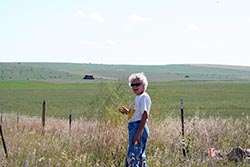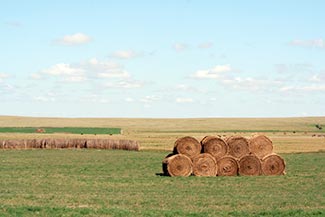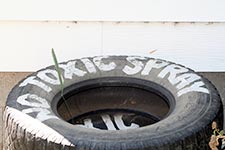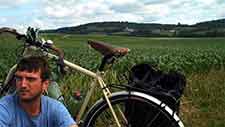[ Editor’s note: Though Nathan is no longer with us, his writings are timeless gems and a testament to his tenacious and inquiring spirit. For those interested in other chapters from his journey across America, there are links at the bottom of each of the pages to provide easier navigation. There’s also a Flickr site devoted to his pictures that capture amazing moments in time of the people and places he encountered along the way.]
I met Emily Stiegelmeier near Route 12 at the intersection of two long and lonely dirt roads near her 4,000 acre farm in Selby, South Dakota. Emily, with her family, owns and operates Blue Blanket Organics where the Stiegelmeier’s plant, grow, and harvest organic spring and winter wheat, flax, rye, barley, and buckwheat. Their family farm is a product of the Homestead Act that originated in South Dakota in 1862. The act offered settlers small plots of barren land in exchange for several years of labor. While over time many of the homesteaders failed, sold out to neighbors, or moved elsewhere, the Stiegelmeier’s remain.
My meeting with Emily was a brilliant and random encounter. After several weeks of horrific headwinds, unavoidable rain, and biking through a lonely tunnel of commercial crops and cattle ranches, I stumbled upon Selby, South Dakota, and found a small café with a room for rent called The Dakota Maid. Owners Sheryl and Rodney Stroh were a breath of fresh air. About the time that I had left Wisconsin and entered Minnesota I noticed a shift in the reaction I was getting from strangers I met along the way. All along the East Coast and into the Midwest, I would barnstorm into a new town and be greeted with open arms, free beer, and food. People would say “Wow! It’s so amazing that you are biking across America.” But out in the Plains, people reacted to my arrival with wariness and caution. The few who did go out of their way to learn more about my journey would say things like, “Why in the hell would you want to ride a bicycle across America? It’s too hot for that,” or, “Aren’t you afraid to be alone? Someone is bound to mess with ya.” Fact is, everywhere I went, and I mean everywhere, the laws of attraction guided me to warm and kind people. Rodney and Sheryl were no different.
Sheryl had the gift of gab and took a shine to my ambition by way of bicycle. Over a fresh catfish dinner and a few cold Hamm’s lagers I mentioned two things: I was in need of a good food and farming story for my research and I wanted to ride in a massive combine. All through South Dakota, large combines roared through the endless crop fields and extracted only what was needed for harvest: wheat for flour, sunflowers for seed, and corn for grain or ethanol, just to name a few. The word “harvest” sounds so pure and natural (just ask any food marketing team) but the picture painted in my mind seemed complex and more like an engineering marvel.
A combine harvester is poles apart from picking berries from the bush. In most cases these machines run a farmer nearly a quarter of a million dollars. They are filled with advanced technology and GPS systems to ensure quality yields and efficiency. If you want to get a solid understanding of the direction agriculture has taken in the past 100 years, go online and take a closer look at the evolution of the combine. I wanted to play with this mammoth toy.
Sheryl’s response was music to my ears, “I know someone you need to meet.” The next morning Sheryl called Emily Stiegelmeier and arranged a visit.
Emily is among the scant 7.7 % female farmers growing crops in the moonlike landscape that is South Dakota. Of that small percentage my guess is that she was probably one of the very few female farmers who were growing grains on a large scale. The story got a few degrees hotter when I learned that her 4,000 plus acres were farmed with no-till practices and certified organic. If you ever find yourself on a long stretch of remote highway in South Dakota, stop and take a look around. More than likely you are surrounded by farmland that is growing a genetically modified crop. Of the 31,300 farms in South Dakota, only 103 of them were certified organic. My encounter with Emily was the equivalent of finding the needle in the South Dakota haystack.
For most of you reading this: 4,000 acres is more farmland than you have ever seen.
In the Great Plains, 4,000 acres is a drop in the bucket. Ranchers and farmers across the prairie regularly own 10,000 acres or more. During my visit to South Dakota in 2009, the state had lofty production yields and was responsible for roughly:
4.6 million acres of corn
4.2 million acres of soybeans
3.8 million acres of hay
3.0 million acres of wheat
2.5 million acres of alfalfa
510,000 acres of sunflowers
90,000 acres of oats
65,000 acres of millet
Anyone who grows vegetables (or any crop for that matter) with organic practices knows and understands how difficult it can be to achieve high quality yields and avoid failure. Pests, blight, diseases, and drought count for just a fraction of the obstacles and complications organic farmers are desperately trying to mitigate. Now close your eyes and multiply that by a few thousand. Blue Blanket was no organic veggie plot with a few interns trying to get ahead of the potato beetles. This was large-scale crop production without the use of synthetic pesticides, herbicides, and other toxic sprays.
Emily and I jumped into her large V8 pickup and zoomed away in search of her daughter, Rachel, who was out in a distant field stacking large round bales of alfalfa. En route, I looked into the sideview mirror of Emily’s truck and for the first time in weeks, I took a good hard look at myself. My skin was a deep shade of brown and the end of my nose was pink with sunburn. For the first time on this journey, and after 3,000 miles of biking, I realized that I was skinny. The few extra pounds I had accrued in my year-long schmooze-fest in Los Angeles the year before were gone without a trace. Knowing that I was in the best shape of my life, I smiled as tiny particles of gravel kicked up into the wheel wells and disappeared into the cloud of dust in our trail.
Emily was a tough nut to crack. She wasn’t the type to volunteer information to a total stranger. And with what seemed to be a sense of wisdom, she stayed reticent when answering my questions. But soon enough she gave me a bit of insight to her background. She was a graduate of Cornell University, where she received an agriculture degree in plant sciences. “How could someone attend college in the bohemian and free-spirited atmosphere of Ithaca, New York, and move to the conservative and remote, middle of nowhere, South Dakota?” I thought to myself. When Emily was finished with her formal education, she was convinced that there was a more meaningful way of life that didn’t include running off and finding a high paying job. She wanted to make a difference in the world. And so she enrolled in the Peace Corps. It was there and through her selfless volunteer efforts where she met her husband, Tim. “I came to South Dakota as an imported bride.” Emily said with a large smile. I smiled back and thought, “Wow. People do some crazy things for love.” For a split second I thought about what it would be like if I were to move to South Dakota…and then the thought passed.
For years, the Stieglemeirs grew their crops in a conventional fashion. Using sprays and toxic chemicals to combat unwanted obstacles in production seemed to be a logical way to farm. In 1984, however, they transitioned to organic practices. Why did the Stiegelmeier’s decide to transition to organic methods and become part of a miniscule group of organic South Dakota farmers? Many farmers, like Organic Valley dairy farmer Dick Hall (whom I met back in Maine) transitioned in hopes of finding financial salvation. For the Stiegelmiers, the decision was driven by a different motive, one that was in line with a trend among a large group of educated and compassionate people I had met on my journey: parenthood.
“When my husband started reading the labels on the chemicals we were using, we were bothered by all of the safety protocols that came along with working with the sprays. They told you to wash your hands over and over and they instructed you to wash your clothing separately along with all kinds of other nonsense. I was pregnant at the time and it just felt wrong. My husband looked at me and said, ‘We should not be handling these chemicals on our farm’.” Emily paused and added, “I lost my husband not long ago in a farming accident.” We shared a few seconds of silence and I expressed my sympathy.
We met Rachel driving in an older tractor carefully stacking 1,200 pound round bales of hay. “How many people can we fit in this tractor” Emily asked her daughter. With a big smile, Rachel replied, “We’ve had five people in here before. Climb on in.” Rachel, in her early 20s was the third of Emily’s seven children. She spoke with a very matter-of-fact tone and was nothing short of talented when it came to her task at hand: stacking 180 bales into 28 uniform piles with a huge claw-like device. Ultimately, these bales will be winter food for her 170 cows and 150 calves. (Grass-fed beef is a value-added income to the Stieglemeier homestead.)
With the tractor humming with both deep vibration and deafening noise, I admired the vast landscape and enchanting view of the land. I tapped Rachel on the shoulder and asked, “Do you find this to be therapeutic?” She quickly repeated my words with slight mockery. “Therapeutic? Ha! Yeah, I think about a lot of things while I am up in the tractor. Like that rain cloud over there. You know how they say that every time you take the time to wash your car it always rains?” Yes, I replied. “Well, every time we cut hay on this field, I swear it always finds a way to rain”.
To offset her frustration, I paid her a compliment. “You’re pretty good at this!” She looked back over her shoulder, smiled at me and said, “That’s because I have had 10 years of practice. But you know, all of these questions are really hurting my average of 1 bale for every 90 seconds.” Point taken.
Emily and I hopped back into her diesel rig and made our way to another 160 acre “quarter section” of her property, where John (the hired man) had been harvesting wheat in their prized combine. As we made our way, I kept my eyes acutely aware of the endless fence posts that defined property lines and separated fields. Every few hundred yards, I would catch a quick glimpse of an old car tire hanging from a post that read “NO TOXIC SPRAYS”.
The setting was idyllic. Mother Nature was drenching fields of wheat with a hard sun that beamed through Emily’s windshield and heated the dashboard until it was too hot to touch. The trail of dust increased and my smile felt permanent.
When we arrived at the combine, John hopped down from the cab of the massive piece of machinery with grace and walked over to greet me with a firm handshake. He was nothing like what I had expected. He was young and vibrant. He didn’t wear a farmers’ cap. He had light blonde hair and blue eyes. Rather than looking like an old-school South Dakota farmer, he resembled a young Steve McQueen. Given his days of long field work, his attire consisted of a sturdy pair of blue jeans, a good pair of boots, and a plain white T-shirt, which he claimed kept him cool in the hot summer sun.
Smitten as a kitten, I hopped into the massive combine and John yelled, “Let me give you a quick walk through on this bad boy before you start touching anything.” Looking around the cab I felt like I was sitting inside of a pinball machine. There were endless switches, gauges, and buttons of all shapes and colors. It had an air conditioning unit and a decent stereo system to help pass the time. All that was missing was a flat-screen TV and high-speed internet. And this was an older model. When it was confirmed that I could behave rationally and not flip any switches without John’s consent we began slicing our way through windrows [long lines of raked hay or sheaves of grain laid out to dry in the wind] of wheat that had been drying on the ground. Directly behind our heads sat the large bin, the hopper, that stores the harvested wheat. It holds nearly 300 bushels of wheat before it is dumped into a truck and taken to the local grain elevator. Each acre was rendering roughly 35 bushels. Basic math told me that each hopper could yield roughly 8.5 acres of harvest. The pile of wheat behind my head was worth about $2,400. Looking around at the seemingly infinite acreage to be harvested that summer I saw dollar signs. I also saw a lot of work.
I asked John how many hours he planned to work each week. “I have been averaging over 70 hours a week. Of course with the rainy days you scale back, but on a good harvest day I might put in a good 20 hour work day.” John said. For a farm kid from South Dakota like John, a 20-hour shift in a combine was hardly unusual. For me, this was a culture that I had never dreamt that I would come to know and understand. I chuckled and said a silent prayer that John relaxes in winter months. Something told me that he finds something to keep himself occupied. Something also told me that 70 hours a week of work in the hot sun is a good reason newbie farmers in South Dakota are an endangered species.
“When did you decide you wanted to be a farmer?” I asked. “I was just born into it I guess. Growing up, my dad was a dairy farmer and he did that until I was about 9 years old. These days he works for another farmer about 60 miles outside Selby. I used to work for that farmer too, but I couldn’t stand the chemicals they used on their fields. Those chemicals affect their minds and the way they think. They don’t know it and they don’t believe it, but I can see it when I talk to them. I like organic farming because it eliminates the harmful chemicals.”
At this point I could hardly believe my ears. I was starting to put things into perspective. Looking at John and his rugged hands that maneuvered the combine, it dawned on me that I was seeing a young, large-scale farmer who was roughly half the average age of the American farmer–age 57–willing to admit that he felt agribusiness was allowing farmers to use chemicals that were harmful to not only their bodies but their minds as well. In the cab of a John Deere combine, I saw that we don’t need cerebral food journalists and documentaries to educate young and future farmers about the health risks attached to chemical-based agriculture. We need more young farmers like John, with their boots, dirty hands, and sunburnt necks, to stand up and speak from the heart.
A pseudo-date of fishing and cheap beer on the Missouri River with Sheryl had been arranged for later in the afternoon and I needed to part ways with the folks at Blue Blanket. John and I met Emily at the end of the long field. I knew that my time with Emily was now short and I wanted to ask her one last question. “How would you define sustainability?” She paused, sighed deeply, and said, “There are a lot of people out there who are trying to define sustainability. ConAgra and similar outfits are defining sustainability to suit their needs. They try and paint this picture that says organic agriculture is not sustainable because you cannot be economically successful. I would say that not only have we maintained the farm here at Blue Blanket but we have also grown. We have done a lot of hard work and there have been some long days, but we have also had quite a bit of fun doing it. Anyway, our definition of sustainability includes keeping people on the land-including our children.”
There are more than 2.1 million farms in America. The large agribusiness entities such as Cargill, Monsanto, and ConAgra have convinced many of these farmers that we need genetically modified crops in order to feed the world. These corporations do not care about the American farmer. They only profit from their exploitation. But in the small town of Selby, South Dakota, population 642, it was clear that our country was experiencing a new paradigm shift within our rural communities, where farmers like Emily didn’t give a damn about the industrial food cartel. Pardon the mixed metaphors, but Emily is not only the needle in the haystack, but she is a diamond in the rough.
Read the Unconventional Harvest series:
- On the Road to Find the Future of Food and Farming
- Grassland Organic Farm
- Wellspring Farm
- My Visit to an Amish Farm in New York
- Farm Sanctuary
- An Urban Oasis for Food
- Tantré Farm
- Conventional Dairy Farmer Art Thelen
- New Forest Farm
- A Large No-Till Organic Farm
- Melstone, Montana—Population 136
- In the Farmers Own Words
Nathan Winters rode a bicycle across America to discover first-hand why our food system had grown to be unsustainable, and to find alternative solutions. He traveled into the homes and communities of organic, conventional, urban and Amish farmers and community organizers. This ongoing series—to be posted every other Wednesday— represents select material from The Unconventional Harvest, a work in progress, by Nathan A. Winters.







